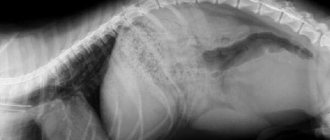Hematuria, or blood in the urine in dogs, is an alarming symptom. The pathological process is accompanied by the release of blood fractions along with a portion of urine during the act of urination. It is extremely important to take a urine test in dogs for preventive purposes. This will allow timely identification of possible disturbances in the functioning of the body, especially if there is a predisposition to this.
Thus, the appearance of blood in the urine may not be noticed by the owner during a visual inspection. The blood will be in a latent state, which can only be detected through laboratory tests. In some cases, the color of urine in dogs may change when taking medications, as well as when feeding foods that can color the urine.
Causes of urinating with blood
Urine with blood in a dog indicates the presence of health problems and necessarily requires treatment. Except in cases where the animal is taking medications or food products that contain any dyes.
Depending on the underlying cause, the color of urine may vary from light pink to brown. In addition, different diseases have different manifestations and symptoms. Accordingly, the treatment required is also different.
Urinary tract infections
The most common cause of a dog peeing blood is inflammation of the urinary system. With diseases of the urethra and bladder, the color of urine changes noticeably. Pets may also exhibit other unpleasant symptoms, including frequent urination, painful urination, or incontinence.
In case of inflammation of the ureters, it cannot always be detected without laboratory tests. Urination itself, as a rule, remains unchanged and painful. However, the daily volume of urine and the animal’s well-being may change, up to a sharp increase in temperature, vomiting and refusal to eat.
Poisoning
If your dog is urinating blood, it may indicate severe poisoning from a rodent poison. When deratization, poison with anticoagulants is often used. They affect red blood cells, destroying them. Other signs of poisoning include weakness, refusal to eat, pale mucous membranes, bleeding, and abdominal pain.
Diseases of the genital organs
If your dog urinates blood and also bleeds between urinations, then the problem is in the genitals. Diseases of the uterus, prostate, and vagina may be accompanied by bleeding, pain, and increased body temperature. In male dogs, if there is inflammation of the prostate gland, even whole blood clots may come out at the end of urination. This condition requires immediate treatment.
Why do dogs leak blood in their urine?
Blood in a dog's urine is almost always a warning sign that there is a serious problem. Bloody discharge may appear for the following reasons:
- Hemolytic poisoning
is intoxication from rat poisons, which act as destroyers of red blood cells. If an animal accidentally swallows such a poison, vomiting, convulsions, pain, and blood clots in the urine may occur. Hemolytics include not only rat poison, but also arsenic, some inedible mushrooms, and snake and spider venoms. It is important to contact a specialist as soon as possible so that he can save the pet by administering sorbents, painkillers, cardiac and rehydration medications. And if you can’t get to the doctor right away, then at home you should induce vomiting by pouring 20-60 ml of slightly warm water into the dog’s mouth. You will also need a water enema and the introduction of sorbents (1 activated carbon per 10 kg of weight). The poisoned poor fellow will need to drink plenty of water, but you shouldn’t feed him;
Urinary tract infections
– very often a dog urinates blood with cystitis, urethritis, pyelonephritis. With such problems, the urine turns red with blood, and the following symptoms may also be observed: pain when trying to relieve a small need, swelling of the genitals (with inflammation of the urethra), temperature, useless attempts to pee, apathy and refusal to eat (due to pain and discomfort ). By the way, with the listed ailments, blood also occurs at the end of urination, when a portion of urine has already been released from the animal’s urethra. And in some cases, only small drops of blood are observed in the urine, which can easily not be noticed, so you will have to pay attention to the general condition of the dog. A disease like this cannot be left to chance. At the clinic, the dog will be prescribed antibiotics, antipyretics, antispasmodics, and rinsing of the urethra and bladder;
von Willebrand disease
– a hereditary pathology in which blood appears from the dog’s urethra, from its nose, and mouth. Heavy bleeding is also observed during surgical interventions (castration, tail docking, etc.). Treatment involves blood and plasma transfusions;
Parasitic diseases
– worms feeding on the animal’s blood destroy red blood cells, which causes the urine to turn red. In addition to urine, the dog's feces also become bloody. The animal loses weight, sleeps poorly, often experiences nausea, and diarrhea alternates with constipation. To eliminate this problem, dogs are prescribed anthelmintics, vitamins and other symptomatic medications. Other pests can also cause blood in the urine - ticks, which also feed on the blood of the animal;
Urates (urinary stones)
in the kidneys, urethra, bladder - similar formations appear in pathology of the liver and blood vessels. If a dog urinates blood, experiencing pain, if the animal is clearly uncomfortable peeing, then the problem may be precisely in the stones, which impede the normal excretion of urine. The appearance of urates contributes to the development of urolithiasis, which also often causes blood in the dog’s discharge. And ICD entails cystitis, pyelonephritis, and renal failure. To help the dog, physical therapy, bladder lavage, painkillers, diuretics, anti-inflammatory drugs and antibiotics are required. But first, it is important to identify what led to the appearance of stones;
Prostate diseases in male dogs
(prostatitis, cystosis, abscess, adenocarcinoma of the gland) - such ailments can not only cause blood in the urine, but also provoke problems with defecation, bouts of vomiting, and urinary retention. Depending on the type of disease, the doctor prescribes either medication or surgical treatment;
Gynecological diseases in bitches
(pyometra, ovarian cyst, etc.) - in such cases, the animal may have bloody urine (or bloody discharge from the vagina), a weak appetite, and a swollen belly. Almost always, removal of the ovaries and (or) uterus is chosen as treatment, since it is impossible to get rid of such diseases with medication;
Damage to the reproductive or urinary systems due to trauma
– drops of blood in the urine may also be present in cases where the dog fell, for example, under the wheels of a car or fell from a height. If an accident like this occurs, it is important to see a veterinarian as soon as possible. The worst thing is if blood in the urine is caused by a severe bruise or rupture of internal organs;
Treatment
Unfortunately, it is not always possible to detect such a symptom immediately. After all, man’s four-legged friends pee on the street, and the coloring itself can be a pale pink, barely noticeable shade. To find out why this happened, you should consult a doctor. Before the visit, you need to collect urine and bring it to the veterinarian.
To make an accurate diagnosis and prescribe productive treatment, it is necessary to conduct a number of studies. First of all, you need to get tested. It is also necessary to give the dog an ultrasound or x-ray examination.
What to do before visiting a doctor?
If the owner notices that the pet is peeing blood, it is better to go to the doctor as soon as possible. It is important to remember that this is serious and you cannot do anything on your own and it is even dangerous. Before visiting the veterinarian, you should pay attention to the following points:
Causes of cystitis and urolithiasis
Contrary to popular belief, a healthy dog or cat cannot get a cold in the bladder by lying in a draft. But this may be the last straw for the disease to activate and your pet to begin to show signs of pathology.
Subclinical inflammation
The disease can develop even when the pet's behavior does not change (subclinical inflammation). This is typical for bacterial inflammation of the bladder, which is aggravated by stress, moving or draft.
Most often, it is because of chronic bacterial cystitis that urolithiasis develops. In this case, urine salts begin to crystallize around bacteria and fragments of the dead bladder mucosa, which form sand and stones. The latter already mechanically irritate and scratch the bladder. This leads to acute cystitis and the appearance of blood in the urine. If a bladder stone travels down the urethra, it can become lodged and block it.
Nutrition and lifestyle
Poor nutrition of the animal and lack of activity can also cause illness. If an animal is obese, moves little and rarely drinks, its urine remains in the bladder for a long time, which is why small crystals settle to the bottom.
Food also affects the acidity of urine, which contributes to the formation of certain urinary stones.
What to do?
Don't self-medicate!
If you feel a full bladder, see a doctor immediately! The pet may die.
If there is no threat to life, you can give the animal an antispasmodic (no-spa) to alleviate its condition. The dose for a medium-sized cat is ¼ tablet, and for a large dog - 2 tablets. This is only a temporary measure; it is necessary to consult a doctor for a clear diagnosis, making the correct diagnosis and prescribing appropriate treatment.
Answer
Finding traces of blood in a dog's urine is a serious sign that makes the owner concerned. As a rule, the symptom indicates the presence of an acute inflammatory process.
The appearance of blood in urine does not necessarily give a red tint. Urine may turn brownish or light pink. Such inflammatory processes are accompanied by lethargy and malaise in the pet. Sometimes redness of urine is not associated with the presence of blood impurities in it. Urine acquires a reddish tint as a result of taking medications or eating foods containing red and orange pigments.
A simple examination is not always enough to diagnose an animal. A number of diagnostic tests are often required in a veterinary clinic. Based on the test results, the doctor will make the appropriate prescription.
How do diseases accompanied by hematuria manifest?
Venereal sarcoma is a common cause of blood in the urine.
The disease is contagious and transmitted through sexual contact. Since hematuria is only a symptom of another disease, you should know how exactly the diseases that lead to the appearance of blood in the urine manifest themselves.
Here are the symptoms of the main ailments accompanied by hematuria:
- Venereal sarcoma. With this disease, a malignant tumor grows on the dog’s genitals, resembling a cauliflower in appearance. The tumor bleeds and is easily transmitted to another animal through sexual contact.
- Nephritis, pyelonephritis in dogs, etc. The causative agents of these diseases are bacteria and viruses. The dog experiences pain in the kidney area, hunches over, and is anxious when palpated. Nephritis is often accompanied by edema, as the animal’s thirst increases and blood appears in the urine.
- Neoplasms in the kidneys. Tumors can be either benign or malignant. In the first case, they may not express themselves in any way. If the neoplasm is malignant, the animal’s health worsens, the pet loses weight, and in rare cases, kidney failure develops.
- Urolithiasis (nephrolithiasis) is a condition in which crystals form in the kidneys and bladder. They injure the mucous membrane, which leads to the appearance of blood in the urine. With this disease, the dog experiences pain in the kidney area, has difficulty urinating, and the ducts are clogged with stones.
- Piroplasmosis (parasitic disease). With this disease, the dog's urine turns dark, almost brown. The pet's condition worsens sharply, the temperature rises (up to 40-41 degrees), the mucous membranes turn pale or yellow.
- Prostatitis and penile injuries. The dog has difficulty urinating and does not eat well. With inflammation of the prostate, weakness in the hind limbs often appears, body weight decreases, and during an exacerbation the body temperature rises.
- Poisoning with drugs or poisons. There is a large amount of blood in the urine. The stool becomes liquid, the dog feels nauseous, and the mucous membranes turn pale due to dehydration.
Reference. Sometimes a dog's urine turns red or brown after eating certain foods (beets, carrots, etc.). This phenomenon is not a deviation and does not indicate the presence of any disease. Blood can also get into a bitch’s urine during estrus, and this is also considered normal.
Why does blood appear in urine?
The pathological process in the genitourinary system, which causes the appearance of foreign impurities in the urine, is sometimes due to the following reasons:
- Infectious diseases in the genitourinary system with different etiologies. It is infectious agents that often cause hematuria in an animal. However, this is not the only symptom. The inflammatory process is accompanied by fever, lethargy, general weakness, and urination problems. Pets begin to intensively lick the area near the anus.
- Urolithiasis in an animal. So-called uroliths are often found in dogs. Accumulating in the bladder and preventing the outflow of urine, stones and sand cause inflammation of the mucous membranes and damage the walls of the ureters and bladder.
- In males, blood in the urine is caused by prostate disease. Unneutered pets are often susceptible to this disease. The dog suffers from elevated temperature, becomes lethargic, and its hind legs can become weak.
- In females, a semblance of prostatitis is pyometra - the formation of purulent contents in the uterine cavity. During urination, pus and blood are released from the uterus.
Causes of bloody urine
Red urine appears not only due to illness, but also when consuming certain foods and medications. If you recently treated your puppy to beets, rhubarb or berries, then the problem is a natural dye. Also, red urine appears in dogs after taking aspirin. It thins the blood and leads to bleeding. Its use is permissible only in severe forms of arthritis under the strict supervision of a veterinarian.
Pathological causes of hematuria include:
- Von Willebrand-Diana disease.
The pathology is accompanied by spontaneous bleeding from the mouth, sinuses and urethra. The most striking symptoms appear during surgical intervention: castration, sterilization, cupping. - Salts (urates, oxalates) in the bladder
. Excessive accumulation of salts leads to the formation of stones and the development of urolithiasis. High concentrations of urates and oxalates are characteristic of pathologies of the cardiovascular system and liver diseases. When the urinary tract is blocked, the mucous membranes are injured. The pain makes going to the toilet a real ordeal. - Infectious diseases of the urinary system
(urethritis, cystitis, pyelonephritis). Pain in the inflamed genitals reduces activity. The sick person develops a fever and loses his appetite. After urinating, the pet licks the genitals and whines. - Injuries to the urinary or reproductive system
. Animals suffer internal injuries when falling from a height or after an accident. When the genital organs are damaged, blood particles are present not only in biological fluids, but also on the outside of the penis or loop. A severe injury can lead to organ rupture and death from internal bleeding. The likelihood of dangerous consequences remains even with an asymptomatic course. The injured pet must be taken to the veterinarian as soon as possible. - Diseases of the prostate gland
(cystic disease, adenocarcinoma, prostatitis). The risk group includes uncastrated males. An enlarged prostate makes it difficult for fluid to drain out. Delays in habitual urination are accompanied by pain and problems with bowel movements. Apathy, vomiting and high fever appear. - Diseases caused by parasites.
Helminths and ticks feed on blood, so they act on the body in a similar way to poisons. Blood in a dog's urine appears due to destroyed red blood cells. Dead cells are excreted along with the discharge, giving it a bloody tint. The patient's body temperature rises, appetite decreases and weight drops sharply. Constipation alternates with diarrhea and bouts of vomiting. Blood clots are observed not only in urine, but also in feces. If their consistency differs little from tomato paste, then the likelihood of piroplasmosis is high. - Gynecological diseases
. Bloody urine in a dog is a symptom of pyometra or infectious inflammation of the uterus. Accumulating pus and blood clots are released along with urine or vaginal discharge. The pet becomes lethargic, its belly becomes rounded. - Malignant tumors
. Metastases that injure surrounding tissues and organs lead to internal bleeding. A striking example is venereal sarcoma. At the initial stage, the pathology resembles estrus. It differs from the natural process by constancy, spontaneity and a stable increase in the amount of secretions.
In some cases, hematuria is unusual.
If the blood appears in clots
Bloody clots in the urine are an alarming symptom that requires immediate contact with a veterinarian. The reason for their appearance may be:
oncological diseases: prostate tumor in males or uterine tumor in females;
a severe infection that causes thickening of the blood, such as leptospirosis;
piroplasmosis after a tick bite – the dog’s condition will be severe;
in rare cases, this way you can find out about the incoagulability of blood in an animal.
Even more rarely, blood clots can be found in a dog’s urine when poisoned with hemolytic poisons. When intoxicated with rat poison, arsenic and some types of mushrooms, the victim's red blood cells are destroyed. Because of this, coagulability worsens, and the dog develops blood clots in the urine. Severe poisoning is accompanied by intestinal upset, vomiting and convulsions. If poison is swallowed right before your eyes, provide first aid and rinse the animal’s stomach with plenty of water.
Other causes of hematuria
If the dog has these symptoms, a superficial examination by a doctor is not enough. It is necessary to conduct laboratory and instrumental studies:
- General blood and urine tests can reveal the presence of inflammatory processes, a decrease in hemoglobin, and changes in the leukocyte formula.
- Biochemical blood tests can determine the protein content in the blood serum, the amount of creatinine and uric acid.
- An ultrasound examination of the kidneys and bladder will detect the presence of stones, tumors, polyps, and signs of inflammation in the urinary tract and prostate gland in the kidneys and bladder. This method is considered fast, effective, affordable and safe. However, the only conclusion of an ultrasound scan does not allow making a diagnosis; it is taken into account in conjunction with the clinical picture.
- X-ray of the abdominal organs can detect stones, sand, signs of inflammation, and neoplasms in the kidneys and bladder. In case of acute urinary retention in a pet, an x-ray examination allows you to determine in which area the blockage of the urinary tract occurred, which was the cause.
- Urine culture for sterility and in the presence of pathogens - determination of their sensitivity to antibacterial drugs.
Symptoms that appear in a dog with hematuria
The appearance of blood in urine during urination is the main symptom of hematuria. In addition, depending on the cause of the pathology, the symptoms will have different manifestations. Pain when urinating causes the animal to suffer. The main symptoms of hematuria are the following:
- red urine discharge;
- increased respiratory rate;
- increased salivation;
- eruption of gastric contents;
- bowel dysfunction;
- severe lethargy;
- anxiety and nervousness of the animal;
- pain in the abdominal area on palpation;
- increased thirst;
- pallor of the mucous membranes of the oral and nasal cavities;
- violation of the act of urination;
- decrease in the amount of urine excreted.
If your dog's urine has a reddish tint, you must immediately contact a veterinary hospital for a clinical and diagnostic examination. Treatment with traditional methods or self-medication with medications can cause serious complications. To make a correct and accurate diagnosis, the veterinarian must collect a complete history and conduct clinical studies. In addition, the following results are important when making a diagnosis:
- general and biochemical blood test;
- a fresh urine test (for this the animal needs to urinate in a clinical setting);
- ultrasound examination of the pelvic organs (renal structures and bladder);
- X-rays of the abdominal organs.
What should a pet owner do?
If the presence of blood in the urine is not a one-time occurrence and is accompanied by other signs, you cannot do without the help of a veterinarian. Try to carefully observe the animal’s condition and note certain points in its behavior and urination process.
- What position is the dog in when urination occurs?
- What is the volume of urine excreted at a time, what shade.
- Does your dog show obvious signs of pain when urinating or when not urinating?
- How often does blood appear in the urine?
- When did such a sign first appear, what do you think it is associated with?
- Are there any signs of bleeding between urinations?
Do not try to carry out treatment yourself, so as not to harm your pet with inept actions. It is better to consult additionally with other specialists. Perhaps the doctor will prescribe additional tests, based on which further treatment is carried out.
A dog urinating blood can be both a warning sign and an unjustified panic.
It happens that the blood in a dog’s urine is not blood at all, but simply foods it has consumed of a specific color: beets or carrots. When a dog takes certain medications, it is also possible for its urine to turn a specific color. In any case, to confirm or refute your suspicions, you will need a comprehensive examination of the animal by a veterinarian.
What to do
The presence of bloody impurities in an animal’s urine is alarming and becomes a reason to consult a doctor. In a specialized clinic, it is possible to conduct a full examination of the pet and provide adequate treatment.
If your pet has blood in its urine and no other pathological signs and symptoms are observed, the dog’s general condition is not a cause for concern and there is no reason to panic. The disease is probably in its early stages and the situation is far from critical.
Do not try to feed your dog hemostatic drugs yourself - you risk causing irreparable harm to the animal’s health. Before giving your dog medication, you should consult your doctor.
If blood in the urine is not the only clinical sign, but is accompanied by weakness, inactivity, decreased appetite, and frequent vomiting, you should call a doctor immediately.
Diagnostic tests for an animal with blood in the urine include:
- General clinical urine analysis.
- General clinical and biochemical blood tests.
- Ultrasound examination of the kidneys.
Treatment for hematuria depends on the diagnosis. It can be surgical, chemotherapy, or conservative. In some cases, hospital treatment is required. Uncomplicated cystitis and parasitic diseases can be treated under the supervision of a doctor on an outpatient basis with the help of medications.
Symptoms of possible diseases in a dog when urinating with blood
If a dog has blood in its urine, then it definitely has some kind of disease. Depending on the location, there are several diseases that are accompanied by urination with blood. This:
- prostate diseases in male dogs;
- diseases of the vagina and uterus in female dogs;
- bladder diseases;
- urinary tract diseases;
- cystitis;
- kidney diseases;
- diseases of the ureters;
In case of diseases of the prostate gland in a boy dog and diseases of the vagina or uterus in a girl dog, blood is clearly visible: it appears not only during urination, but also when the animal is in a state of absolute rest.
For diseases of the bladder and urinary tract, the following symptoms are observed:
- frequent urination;
- urinary incontinence;
- when urinating, the dog whines because it feels painful;
- As for activity and appetite, they remain the same.
Symptoms of kidney and ureter diseases include:
- the dog loses its appetite;
- the animal becomes lethargic and passive;
- Urinary frequency may not change.
Of course, if you notice these symptoms in your dog, you need to call a veterinarian.
In case of diseases of the prostate gland in a boy dog and diseases of the vagina or uterus in a girl dog, blood is clearly visible: it appears not only during urination, but also when the animal is in a state of absolute rest.
What to do if your dog is urinating blood
When seeking help from a veterinarian, you should keep in mind that the doctor will require the following information from you:
- What color is urine? Pathology can be noticed if the urine has a light pink or even coffee tint.
- How often has the animal gone to the toilet in the last 24 hours?
- Does your pet experience pain during urination: he may whine pitifully, squeal and even bark.
- If there is bloody discharge in your pet's urine.
- Is blood present in the animal’s urine all the time or does it appear from time to time?
- How long have you noticed blood in your pet's urine?
Perhaps this information alone and a comprehensive examination of the pet will not be enough to make a correct diagnosis, so the doctor may refer you for an ultrasound of the internal organs. Do not forget that ultrasound examination can only be done with a filled bladder. Of course, it is difficult to control the process of urination in an animal, especially if the pet suffers from urinary incontinence. Try to give your pet a good drink before the ultrasound - this way the bladder will not empty soon, which means it will be easy to do an ultrasound examination.
Methods for treating hematuria in dogs
If you notice that there is blood in your pet's urine (it has turned an unusual color: pinkish, brick, red, etc.), contact your veterinarian as soon as possible. Any cause of hematuria threatens the dog's health.
To confirm the presence of blood, the animal’s urine is examined in the laboratory under a microscope (the number of intact, undestroyed red blood cells will range from 5-8 to 31-100 units).
Urine is colored differently (depending on the underlying cause):
- if it is completely pink or red, this indicates damage to the bladder or kidney parenchyma;
- if blood is contained only in the last portion of urine, this indicates cystitis or prostatitis;
- if blood appears periodically and in different portions of urine, this indicates problems with the urethra or genitals.
When making a diagnosis, be sure to take into account the pet’s general condition and other symptoms (vomiting, weakness, fever, etc.). Ultrasound examination and x-rays can evaluate the condition of the kidneys and other internal organs. The prostate and bladder are examined by palpation through the rectum.
If blood in the urine appears due to stones, most often they are removed surgically or prescribed a diet. If the ducts are blocked, a catheter is installed to drain urine. If hematuria is a consequence of venereal sarcoma or other oncology, several courses of chemotherapy are administered.
Using ultrasound, the condition of the kidneys and other internal organs is checked.
In almost all cases, antispasmodics (to relieve pain), hemostatic and anti-inflammatory drugs, vitamins and immunomodulators (etc.) are prescribed to strengthen and maintain the functioning of the immune system.
Important.
Any treatment should only be carried out by a specialist. Under no circumstances should you prescribe medications yourself, as this can only harm the animal.
Hematuria is a symptom of a disease. In some cases, the root cause does not threaten the pet’s life, in others it poses a serious danger. If you notice that your dog is experiencing discomfort while urinating and there is blood in his urine, contact your veterinarian for help.
A change in the color of a dog's urine indicates the presence of some pathological process in the animal's body. The exception is when the dog consumes products with coloring ingredients. The appearance of blood in a dog’s urine is a serious problem and requires immediate identification of the cause of the disease and urgent treatment.
How to collect urine for analysis from a dog
Often, if a disease of the genitourinary system is suspected, a urine test of the pet is necessary. Collecting urine from a dog is very problematic. However, if you adhere to the following rules, you can do this quickly and easily:
- Wear gloves.
- Remove the litter from the tray and rinse it thoroughly.
- Insert a grate into the tray and wait until the dog wants to relieve itself.
- Once the job is done, take the tray and carefully pour its contents into a collection glass.
Perhaps this information alone and a comprehensive examination of the pet will not be enough to make a correct diagnosis, so the doctor may refer you for an ultrasound of the internal organs. Do not forget that ultrasound examination can only be done with a filled bladder. Of course, it is difficult to control the process of urination in an animal, especially if the pet suffers from urinary incontinence. Try to give your pet a good drink before the ultrasound - this way the bladder will not empty soon, which means it will be easy to do an ultrasound examination.
It should be remembered that the shelf life of urine for analysis is not long - only 3-4 hours, so you need to collect urine from your pet at least three hours before going to the laboratory, not counting the time spent on the road.
If you don’t use a tray to relieve your dog, but, for example, a diaper or outside, then buy a special urine collector at the pharmacy. This is a very convenient and practical thing that will allow you to collect the required number of tests in a matter of seconds.
Diagnosis and treatment
If at the time of detection of the problem there is no direct threat to life, observe the pet for 6-12 hours before going to the veterinary clinic. To make a diagnosis, the doctor will need the following indicators:
presence and severity of pain;
amount and shade of urine excreted;
features of posture when relieving yourself.
The stronger the pain, the more exotic the position of the unfortunate animal. A sick male does not lift his paw, but sits down as close to the ground as possible.
After a clinical examination and history taking, urine and blood are taken from the animal for general and biochemical analysis. If prostatitis is suspected, a semen sample is examined, and if pyometra is suspected, a vaginal smear is examined. An X-ray of the abdominal cavity and an ultrasound of the bladder and kidneys are required. Additional diagnostic methods include endoscopy and biopsy.
A treatment regimen is prescribed only after diagnosis. When constructing it, the doctor relies on the cause of the ailment. Most situations can be resolved with drug therapy. Surgeries are recommended only as a last resort when other treatment methods remain powerless.
von Willebrand disease
Urolithiasis and infections
If there is excessive accumulation of salts or the formation of stones, the dog is given painkillers and prescribed a course of antibiotics, anti-inflammatory and diuretic drugs. In advanced cases, the bladder is washed. During treatment, it is recommended to change the food and switch to a veterinary line. Urinary tract infection is treated in a similar way.
Helminthiasis
Diseases caused by parasites are treated with anthelmintic and acaricidal drugs. When secondary infections occur, antibiotics are prescribed. To restore internal microflora, it is recommended to take a course of probiotics, vitamin and mineral complexes.
Diseases of the genitourinary system
Gynecological diseases are treated only surgically. The likelihood of relapse is minimal with complete sterilization. In this case, both the ovaries and the uterus are removed.
Males have a chance to do without surgery - a course of antibiotics is enough. But in this case, there is a risk of developing a chronic disease, which will require re-treatment in case of relapse.
Severe poisoning
In severe intoxication, the animal loses a large amount of fluid. Infusions of saline solution can help prevent dehydration. The effect of the poison is suppressed by the introduction of an antidote. Further treatment depends on the symptoms.
Malignant tumors
Oncology is treated surgically followed by a course of chemotherapy. The exceptions are elderly dogs and animals with chronic diseases. They have a hard time with anesthesia and radiation. Despite the fact that all nearby tissues are cut out along with the tumor, the likelihood of relapse remains.
Injuries
As a rule, after an injury, a pet requires surgery and a further recovery period. It may drag on, but with proper treatment, hematuria quickly goes away.
Preventing bloody urination in dogs
To prevent your dog from urinating blood, you need to carefully monitor his diet, take proper care of him, regularly show him to the veterinarian, make sure he is not overcooled and drinks enough water. Only proper care, care and attention of its owner will help to avoid such health problems, and then not only urination with blood, but also any other sore will bypass your pet.
Normal urine in dogs is straw-yellow in color and has no distinct odor. If the color of the discharge changes, this may indicate that there is a pathology in the body. Dark mustard color of urine indicates dehydration, and orange color indicates liver or gallbladder disease. Urine that is too dark, brown or almost black, may indicate the presence of a malignant tumor. Discharge with blood, in turn, is a symptom of various disorders that may pose a danger.
Causes
Often, the presence of blood in the urine occurs with quite serious pathologies. The reasons for this phenomenon may be the following:
The presence of blood in the urine is most often a consequence of the presence of serious pathological conditions that require treatment. If this happens once, then you need to carefully monitor the dog for some time and remember whether the pet has eaten beets or other brightly colored vegetables that can cause a change in the color of urine.
If the pathological shade of discharge is accompanied by additional symptoms:
- Drowsiness and apathy, lack of mood and decreased normal activity.
- Nausea, dizziness and vomiting.
- A change in behavior, for example, the dog tries to hide in a secluded place or shows unusual aggressiveness towards others.
- Demand for increased attention from the owner, etc.
It is then necessary to urgently contact a veterinarian for an accurate diagnosis and adequate treatment. After all, timely correction of the condition and correctly taken measures are a guarantee of recovery.
Diagnostics
The doctor collects anamnesis, analyzes complaints, in-person examination and studies symptoms. For diagnosis, blood and urine tests of the animal, x-ray and ultrasound examinations are prescribed.
The dog owner himself needs to pay attention to:
- General condition of the dog: presence of elevated body temperature, amount of food consumed, consistency of stool.
- From which part of the body does blood come out? It is important to determine whether the stool contains blood or whether it is only in the urine. In diseases of the reproductive system, droplets of blood are released from the genitals. To understand what caused the urine to become stained, you need to look under the dog’s tail; the bloody discharge will probably come from the organ where the pathological process occurs.
- Does the animal experience pain when urinating? In this case, whining, increased breathing or barking is observed.
- The position in which the pet performs the process of urination. It may not be completely unnatural. For example, the dog squats too low.
- Frequency of trips to the toilet. With some diseases, urination can be difficult, which causes frequent desires to go small, which do not lead to the desired result. Thus, visits to the toilet become more frequent and the amount of urine produced decreases. Or maybe just the opposite - it increases.
- Daily diuresis. You need to pay attention to the volume of fluid that the dog’s body secretes. The presence of urolithiasis causes the inability to productively visit the toilet.
Treatment
Treatment is usually aimed at eliminating the causes of bloody urination. After all, such a phenomenon in itself is not dangerous, but it can be caused by quite dangerous diseases. The doctor prescribes medications that are indicated for the pathologies that provoke the symptoms. If necessary, hospitalization and surgery may be indicated. Self-medication in such cases is simply unacceptable.
The presence of blood in the urine and in a dog can be a symptom of many different pathologies and diseases. Such things should never be left without due attention, since most of the pathologies that are accompanied by this are quite dangerous to health and can lead to death. It is for this reason that the situation requires especially careful attention and timely contact with a veterinary clinic in order to prevent the situation from worsening.
Blood in a dog's urine: causes
1.Injuries.
If the animal has been subjected to external physical impact (a fight on the street, an accident), which has led to the dog’s inability to stand on its feet, a hunched back, pain in the abdomen and perineum, as well as blood in the urine, you must immediately take the pet to a veterinary clinic. In this case, the kidneys and bladder are most likely damaged.
2. Diseases of the genital organs.
In males who have avoided castration, blood in the urine occurs with pain, fever, lethargy or excessive activity, and lack of appetite. In females, pus with impurities accumulates in the uterus and is released through urination. Delaying contact with a specialist can lead to disastrous consequences; moreover, treating advanced cases is much more difficult and expensive.
4. Poisoning.
Intoxication of the dog leads to the appearance of blood in the urine. A similar condition can occur if an animal eats a poison used to kill rodents. Symptoms of poisoning include vomiting, diarrhea, discharge from the eyes, and pain. In such cases, gastric lavage and deintoxication treatment are prescribed.
5. Neoplasms and tumor processes.
This is more common with older dogs. Accompanied by blood in the urine and the general serious condition of the animal.
6. Cystitis
.
The inflammatory process of the mucous membranes of a dog’s bladder is characterized by blood in the urine, pain, and an acute unpleasant course of the disease. Bacteria that cause irritation to the walls of the bladder get there from the anus located next to the urinary canal or even from the oral cavity. Hypothermia or stress can cause cystitis. Bacteria, which are normally found in the urethra, then begin to actively multiply and rise higher up the urethra, causing inflammation. Cystitis most often occurs in females. Treatment of the disease requires effort and patience and should be carried out under the supervision of a specialist.
Symptoms and diseases
There are a lot of diseases, the symptom of which may be the appearance of blood in the urine.
Inflammatory processes in the genitourinary system and bacterial infections
Leptospirosis
- a very dangerous infectious disease. Already on the second day after infection, the dog’s urine and feces contain mucus and blood clots, as well as blood spots. It threatens with very disastrous consequences, start treatment immediately.
Pyelonephritis
– occurs due to microorganisms entering the kidneys, due to hypothermia, as well as against the background of other diseases of the urinary system. In this case, the urine is cloudy with blood, a false urge to urinate is observed, swelling occurs and the gait changes. If left untreated, it leads to chronic kidney failure and the formation of a purulent abscess.
Cystitis
- cystitis. Urine becomes cloudy, mixed with blood and has an unusual odor. It hurts the dog to urinate, she whines during the process, males stop raising their paws and do it “like a girl”
Urethritis
– usually develops as a complication after an infection. The urethra swells so much that the dog cannot urinate, resulting in stagnation of urine, which threatens intoxication. With this disease, the dog cannot urinate for a long time, experiences pain and discomfort, whines, and the urine is dark due to pus. In advanced stages, blood streaks are observed in the urine. Without treatment it leads to sepsis and various neoplasms. Possible death.
Prostatitis
– inflammation of the prostate gland. Usually observed in males over 5 years of age. In this case, the dog does not eat, defecation is difficult, and blood clots come out at the end of urination. For prostatitis, it is necessary to begin treatment as quickly as possible before the disease becomes chronic.
Endometritis
(pyometra) - mainly occurs in bitches after childbirth. In this case, blood appears regardless of the act of urination, that is, from the genitals there is periodic discharge of a purulent-bloody color with an unpleasant odor. Without treatment, the animal may die.
Vaginitis
- occurs more often in young bitches who have not yet been in heat. The disease can be noticed because the dog constantly licks the loop, pus with blood impurities is released from it.
Poisoning
The most dangerous thing is poisoning from rat poison. Red blood cells are destroyed. Blood clots come out in the urine, the dog vomits, and convulsions may occur. Immediate veterinary attention is required. If this is not possible, induce vomiting in the animal, you will also need an enema and the introduction of sorbents, you can use activated carbon, enterosgel, smecta.











